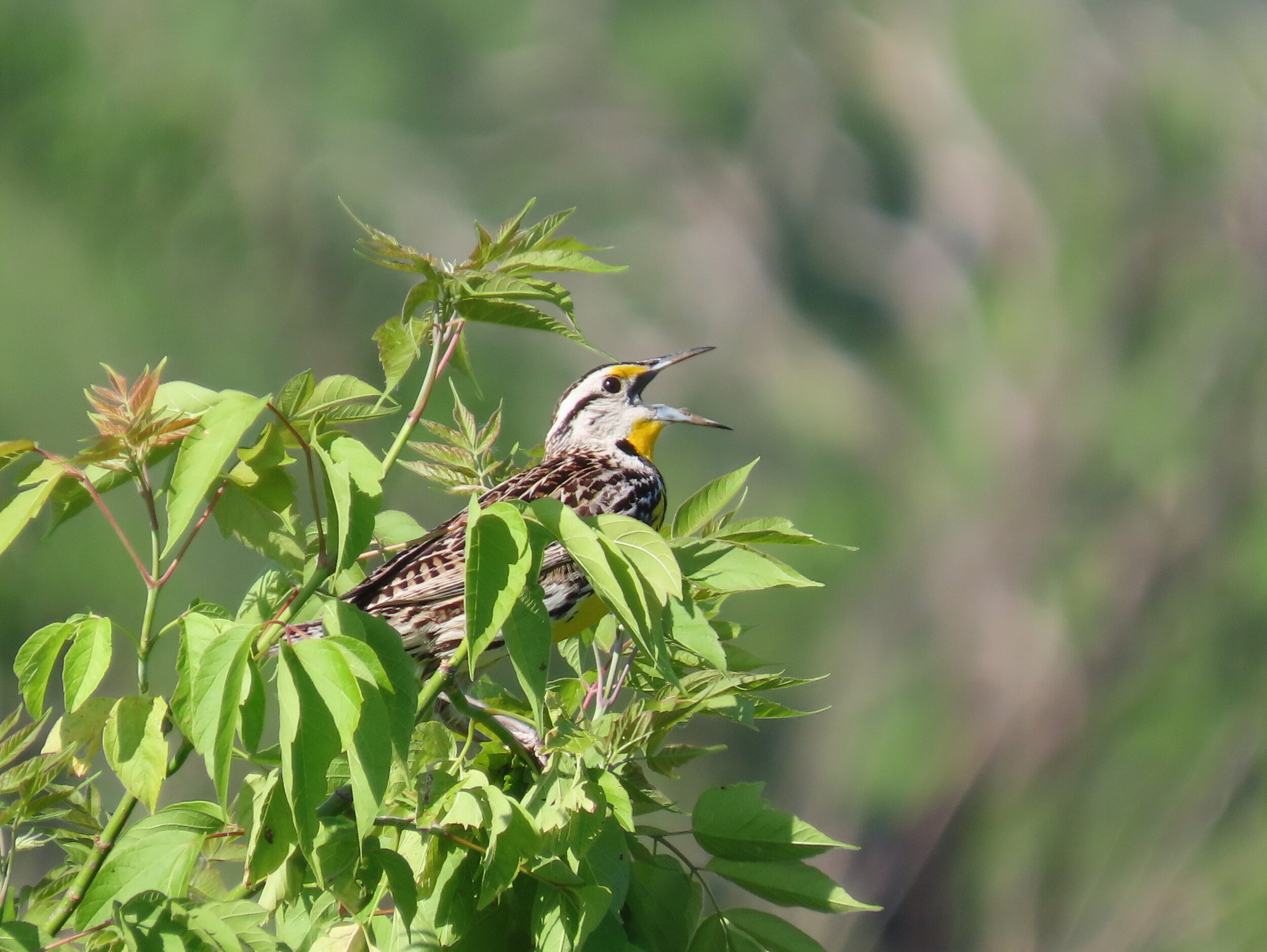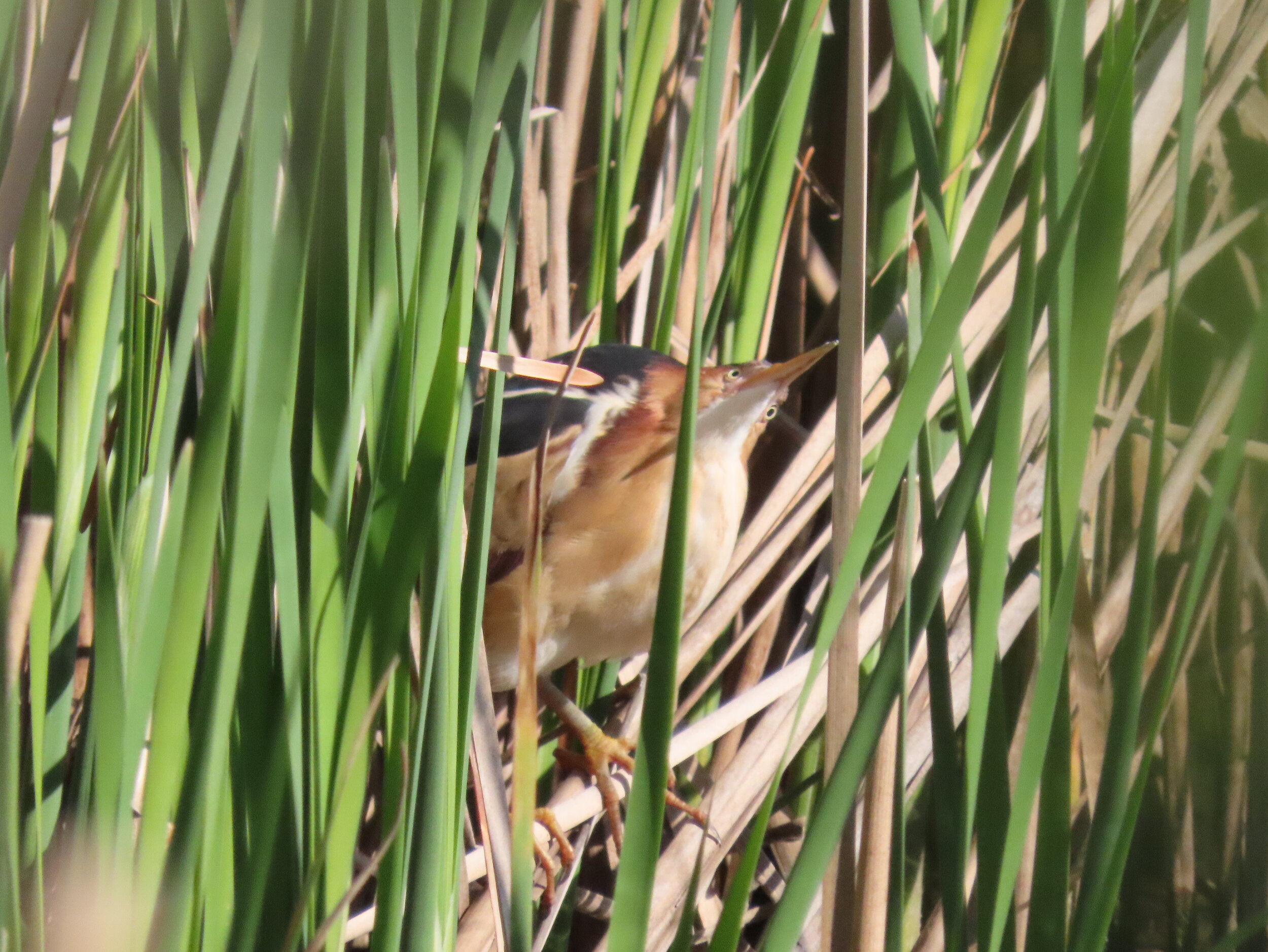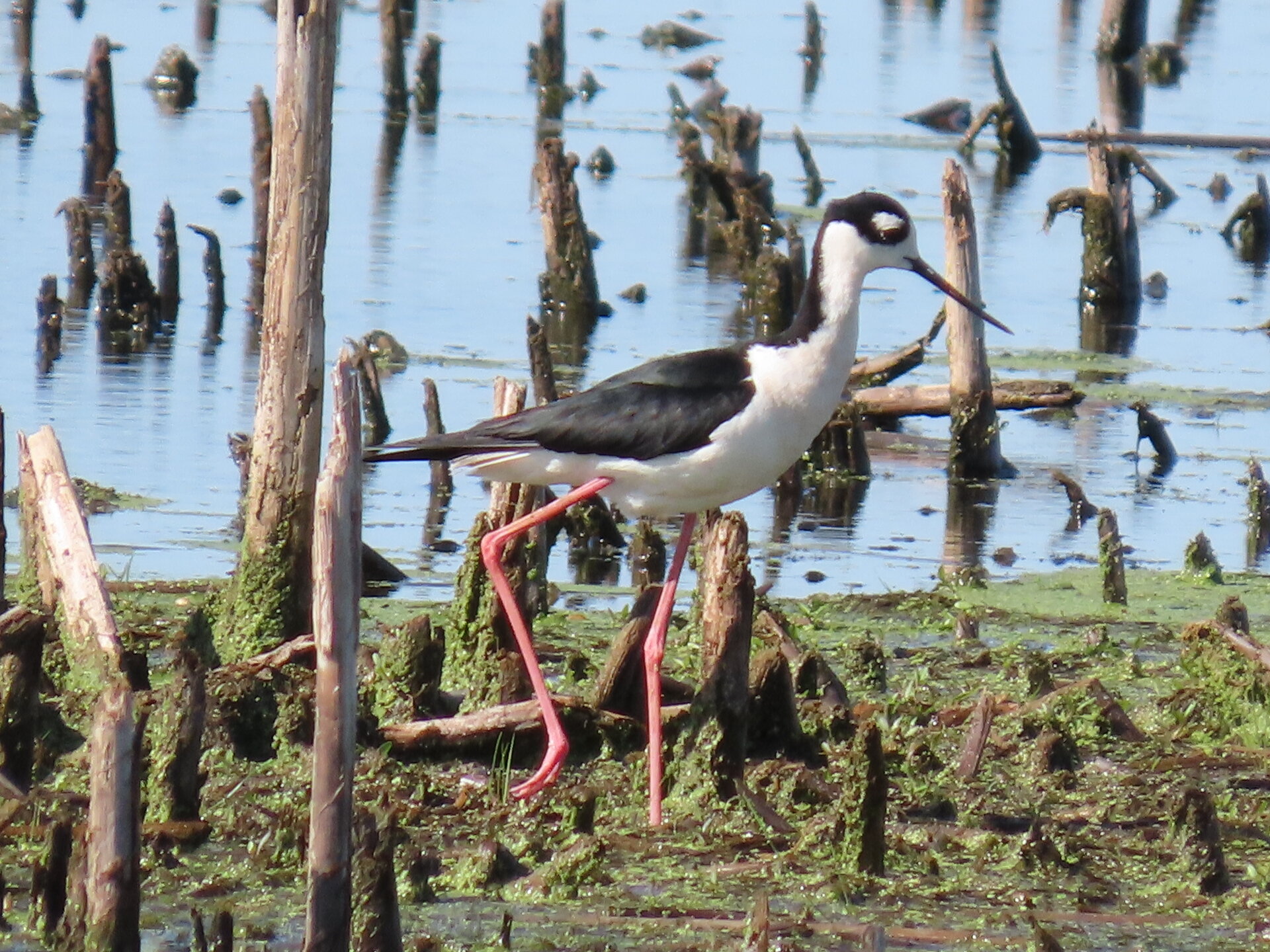If you’ve been following the Entryway to Birding blog, you’ve likely caught me waxing poetic about the wonders of eBird, a citizen science platform for recording bird observations. When I was first introduced to birding, all the wonders and curiosities of the bird-world unfurled before me. But getting introduced to eBird? That’s what gave me the tools and confidence to explore that new and exciting world, and my birding hasn’t been the same since.
This week’s blog is for all of you who might be curious about eBird and all of its potential. eBird has a wealth of resources to offer you, and you likely have more than you expect to offer it in return.
Look at this eastern meadowlark I saw at Governor Nelson State Park. Can you hear him? He’s singing, “Don’t forget to add me to your eBird checklist!” Photo by Caitlyn Schuchhardt
I was chatting with a newer birder awhile back and they mentioned in passing that they didn’t feel like a “good enough” birder to be using eBird. They weren’t confident identifying birds beyond the more common visitors and felt too inexperienced to have much to offer. I can relate to that feeling a lot—it was one of my initial worries when I started submitting my own checklists. I learned soon enough, though, that my fears were unfounded—yours likely are too!
I was lucky enough to get a photo. Look at these gorgeous pelicans take flight! Photo by Caitlyn Schuchhardt
eBird is for everyone. And that means new birders and experienced birders alike. If you ID’d a flock of American white pelicans while out biking on the Oregon Rotary Trail, it doesn’t matter if you’ve been birding for two months or for five years—you saw those birds and can report that they were present. Maybe you’ll even upload a photo of it if you were lucky enough to get one!
There is no expectation that you report every single bird you encounter on your outing—especially if there are birds you’re not comfortable IDing yet. And it’s near impossible to actually detect all the birds that are hiding out there, so don’t be thinking that you need to record every single individual present at your location—you’ll never know half of them are there anyway!
eBird will ask if you are reporting “every species you could identify to the best of your ability, by sight and/or sound.” The key here being to the best of your ability. You’re not going to know all our bird species right off the bat, but that shouldn’t hold you back from sharing your observations and contributing your data. (Heck, you can even report “incidentals”—birds you just happen to run across while you’re not specifically birding. Did you see a great blue heron fly over Lake Monona while out on a bike ride? eBird that!)
This is what citizen science is all about! Real people, real observations, reporting what they find in the field. And I guarantee that the more you get out birding (and eBirding), the more you’ll start exploring what eBird can offer, learning about new species in your area, and IDing new birds. Your life list will grow. You’ll become more confident in your sightings. You’ll get a better understanding of our local bird population. And you’ll love it. I promise.
If you’re feeling at all anxious about your skill level being a factor, rest assured that eBird expects new birders to be logging their sightings and they’ve built in features to help protect data quality and make sure that you aren’t mistakenly listing some crazy rarities that wouldn’t be found in your area. Don’t let your fears of being a “good enough” birder get in the way of valuable contributions you can make to this awesome citizen science program that supports bird conservation all across the globe.
Your birding matters! Your sightings matter! If you find yourself agreeing with any of the statements below, then be confident that joining eBird is right for you.
7 Reasons Why You Should Be On eBird
1. You want your sightings to contribute to science and conservation that protects birds.
If you’re reading this blog, then chances are you care about birds. You want to protect them. You’re aware that we’ve lost 3 billion birds since 1970—and that more are still threatened. All across the world, there are scientists studying bird populations, bird density, and migration patterns … and they’re doing it with the help of eBird data.
Grassland birds, like the dickcissel pictured here, are especially important sightings to note, since their habitat is often threatened. Photo by Caitlyn Schuchhardt
You might be thinking, well, what would my sightings here in Wisconsin have to contribute? How useful is my data, really? I think you’d be surprised. The data you help collect could go on to be used in a project by the Wisconsin DNR, the Wisconsin Society for Ornithology (WSO), the Wisconsin Bird Conservation Partnership (WBCP), or more. Your sightings could be part of a data set used to support local conservation efforts, shaping decisions about how land is used and protected.
There’s a lot of ground to cover out there and scientists can’t do it all by themselves. If you’re out exploring your area and counting birds anyway, why not put that data to use? Every time you record your sightings, you’re helping fill in the bigger picture of what’s happening in the bird world.
2. You want to keep track of your life list and bird photos or recordings.
Most birders will keep a “life list” or a list of all the bird species that they have seen. It may initially start as something you record in a journal or even keep in your head, but as you grow as a birder and start seeing more and more species, you’ll likely want to remember what you’ve seen and where you’ve seen it. eBird keeps track of your life list for you—effortlessly. As you submit checklists, bird species you are listing for the first time will automatically be added to your life list. You can click through the birds on your life list to look back on all the places that you’ve seen that particular bird species.
(If you’ve been birding for years and want to make the jump to eBird, don’t worry—they’ve got a protocol you can follow so you can get your life list uploaded and your eBird account accurately reflecting your sightings.)
Here’s a photo of one of the more recent birds on my life list—an American bittern, hiding among the reeds! I’ve been looking for one of these sneaky birds for a looooong time. Can you tell from this picture why they are so hard to find? Photo by Caitlyn Schuchhardt
eBird also allows you to upload media (photos or audio recordings) to your checklists, and you can view your collection of media anytime you want. Your pictures are copyrighted with your name and they become part of the Macaulay Library of wildlife media. If you spend time on eBird exploring birds, you might find yourself flipping through picture upon picture of other people’s sightings. Your photos, like theirs, will be useful to hundreds of other eBirders as they work to improve their ID skills and learn more about birds.
3. You’re curious what other birders are finding in your area.
If you’ve picked up birding as a hobby during the pandemic, chances are you haven’t been out on a bird walk or gone on a birding field trip. You might not have met any other birders yet, so where might you get the lowdown on what cool sightings are happening around town?
When everyone was reporting finding a least bittern in a marsh on the west side of Madison, eBird gave me the help I needed to find it. And oh, look at that googly-eyed face—totally worth the trip! Photo by Caitlyn Schuchhardt
That’s where eBird comes in handy again. eBird clues you into what other birders in your area are seeing while they are out birding. There’s no guarantee you’ll be able to see those same birds (remember, there are no guarantees in birding!) but it gives you an idea of what you might expect. And if there’s a bird species out there that you’ve been wanting to find, you can keep track of when and where other people are seeing it.
Learning from other people’s sightings is a large part of how you grow as a birder and eBird is there to give you access to that info, even if you don’t know other people in the birding community just yet.
4. You’re interested in seeking out a particular bird species.
What sets the “birders” apart from the “birdwatchers”? There’s debate about the nuanced difference here, but the general consensus is that birders will seek out birds. They’ll go looking for them, where a birdwatcher might just be admiring the birds that happen to be in front of them at the moment. Both birders and birdwatchers are 100% awesome and these categories overlap constantly, so chances are you’re probably both (I sure am!).
But you might wonder how birders—if they are out on the chase—know where to go and how to find birds they’re looking for. The answer? Yep, you guessed it. eBird.
A few weeks ago, I wrote up a blog post “The Beginner’s Guide to Finding Birds,” that walks you through some ways that you can use eBird to find and explore species in your area. Take a look if you haven’t read it yet—you’ll get a taste for just how powerful eBird is as a search engine for bird locations.
Thanks to eBird, I knew this stunning shorebird—a black-necked stilt—was breeding this year at Horicon Marsh in Dodge County. And thanks to eBird again, I knew that folks were reporting seeing young chicks, so I looked carefully and got to see those little cuties too. Unfortunately the little ones didn’t want to pose for any good pictures, but that’s okay. Photo by Caitlyn Schuchhardt
5. You’d like to explore new birding areas near you.
Birding is a fantastic way to get to know your local landscapes. I’ve lived in Madison for seven years now, and it’s only been in the past year—when birding became part of my life—that I’ve really started to understand just how many stunning natural areas south-central Wisconsin has to offer.
eBird’s Hotspot Explorer can help you identify popular birding locations all over the world. If you’re traveling to a different state or county you’re unfamiliar with, eBird’s got your back. If you don’t know where to go, visit one or two of the top eBird hotspots and chances are you won’t be disappointed.
You can also read more about how to navigate the Hotspot Explorer in my aforementioned blog post, “The Beginner’s Guide to Finding Birds.”
I ventured out of Dane County a few weeks ago and went up to visit Necedah Wildlife Refuge, pictured here in this panorama. Imagine what other gorgeous landscapes you might discover through birding! Photo by Caitlyn Schuchhardt
6. You want to improve your bird and birding knowledge.
eBird is a project from the Cornell Lab of Ornithology, the same folks that make the handy Merlin ID app that I’ve introduced you to before. As you browse the bird species pages on eBird, you’ll see brief field guide info from Merlin but wayyyy more pictures than you might find in just the Merlin app alone. eBird will show you pictures taken by birders just like you! You’ll also see a wealth of data about the distribution of a bird in your area to see how common or infrequent it might be, and what time of year you’re likely to find it.
Species pages will help you learn more about birds, but browsing other birders’ submitted checklists will also help you pick up more birding knowledge. You’ll get a sense of what species are prevalent at certain birding destinations. You’ll occasionally run across checklists with comments and descriptions about a notable or unique sighting, which can give you more information about how you might find that bird too. If someone witnesses a bird doing a unique behavior, they might explain what’s going on and share some photos. Small details like this will add up as you explore more checklists, and you’ll get a sense of what other birders are looking for in the field so you can improve your birding skills too.
7. You’re looking for a challenge or a healthy dose of competition to up your birding game.
If you want to set a friendly competition with a friend about how many species you might see this year, I guarantee it’ll light a fire under you and get you out birding more often. But even if you don’t have any birder friends yet (the time will come!) you can set up some really fun challenges for yourself.
eBird not only keeps track of your life list, but it will keep track of all the birds you see in each county, state, and country, so you can challenge yourself to up your species numbers in nearby counties—with the added bonus of getting to explore new, fun places! For example, I bird most heavily in Dane County so I’ve been focusing on upping my species count here. But I’m already planning for where else I might visit to get my other county numbers up soon!
This is a map of places I’ve birded in Wisconsin. It needs more orange and red, stat! Screenshot from my eBird profile at eBird.org
One of my ongoing personal challenges is to light up my Wisconsin eBird map, pictured above. There is a lot of gray space on my map, which are counties I haven’t birded in. I want to fill it up with color. I have a LOT of counties to visit yet, clearly, but that just means I won’t ever get bored anytime soon. (It’s a good problem to have!)
I also have been challenging myself to submit an eBird checklist every day—I started just after Christmas and I’m already up to a 177 day streak! It’s great motivation to get out birding every day—even if it’s just birding from my apartment window when I’m feeling too busy.
eBird can also help you set up a yard list so you can keep a record of what birds you’re seeing just at your yard, or you can set up a “patch” list and monitor what you’re finding in your patch. (In birding lingo, a patch is generally a location close to your home that you bird frequently.) Some folks set up a radius from their home, others focus on particular areas. Either way, you can challenge yourself to find more birds for your yard list or your patch list, and grow your life list in the process!
There is so much you can contribute to eBird, even as a new birder. And in return, you can take advantage of a whole host of resources designed to help you become a better birder and feel more involved in the birding community.
eBird Essentials is an awesome free course that I recommend any birder using eBird take! Learn more here.
I encourage you to explore the eBird site, to make a (completely free!) account, and to start playing around with the many cool features you’ll have access to. If you’re hesitant about sharing your contributions yet, that’s okay. Feel free to ease into it. Wet your toes a bit. Bird anonymously if you’d like, and don’t worry about mis-IDing a bird or two. Everyone does it. And I mean everyone. Mistakes are part of birding and a critical part of improving our skills.
Next week, we’ll take a look at what goes into submitting a checklist and you can see just how easy submitting your observations can be. But if you can’t wait to get started, check out eBird essentials, an online, at-your-own-pace course you can take to learn the ins and outs of eBird on your own.
See you next week, and happy birding!
_____
Caitlyn is the Communications and Outreach Assistant at Madison Audubon. She’s crazy for birds because they changed her life. She’ll be back next Monday with some tips and tools for birders, new and experienced! Between now and then, she’d love to hear about the birds you’re seeing and hearing. Leave a comment below or email to drop her a line!












